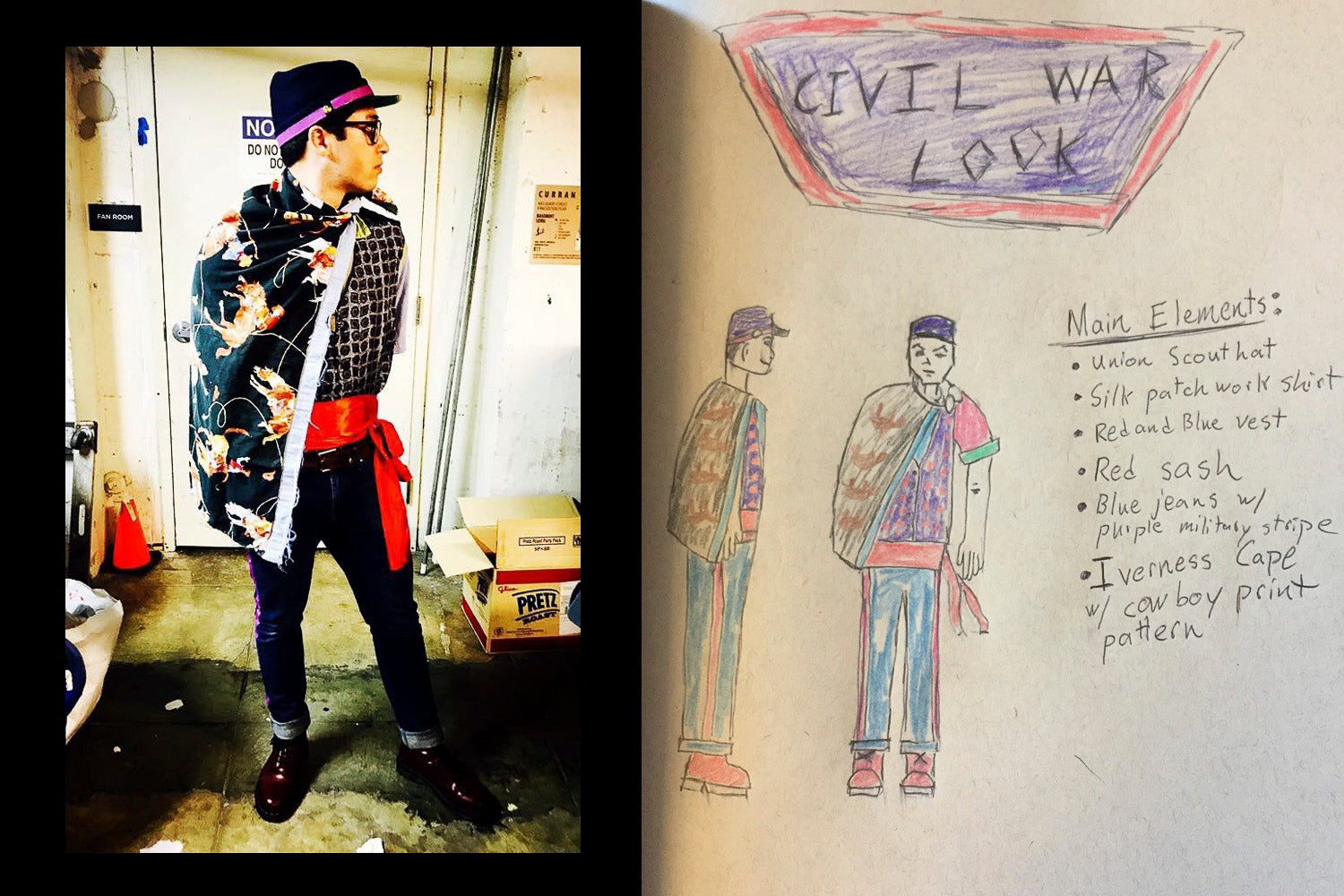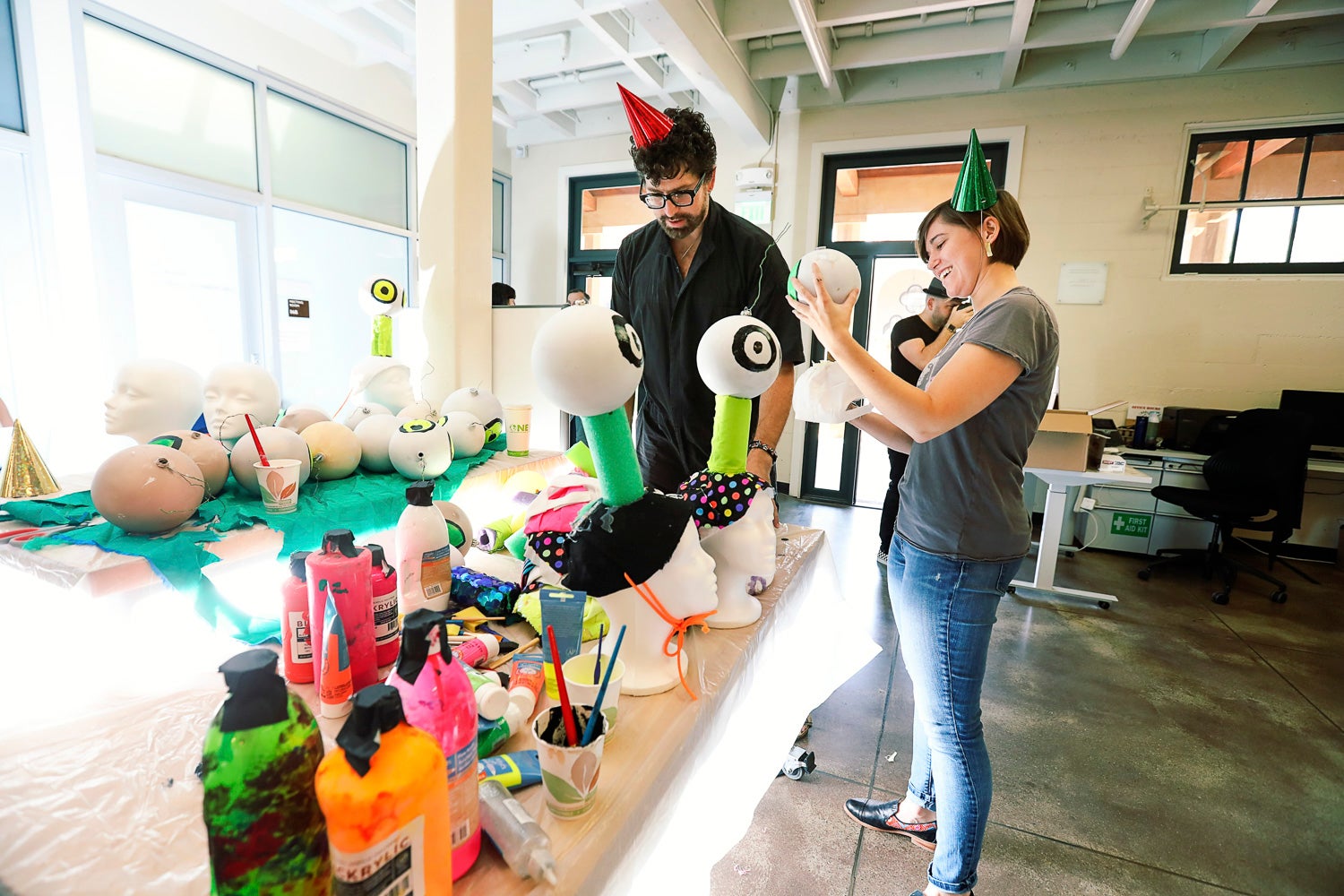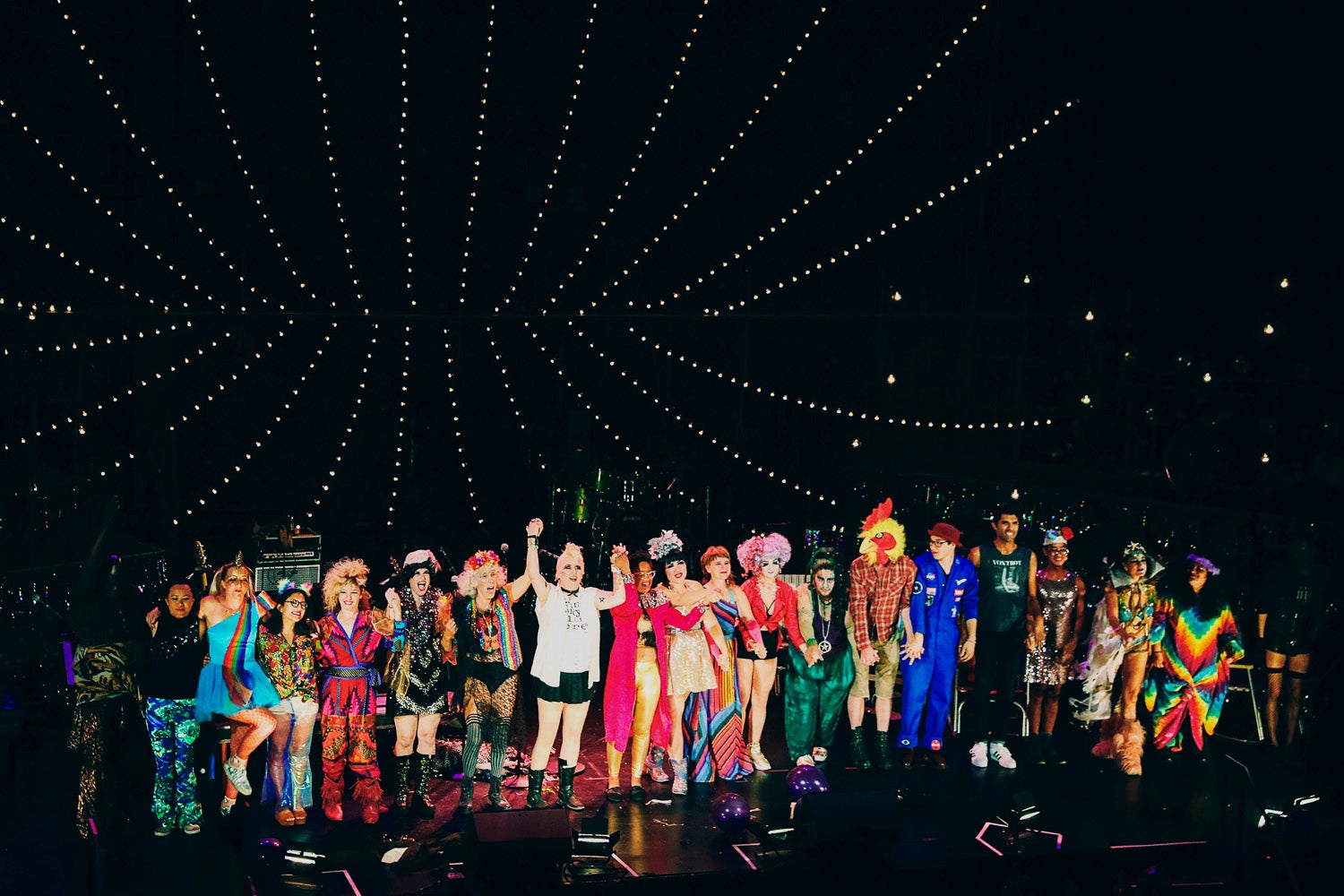Research the cultural history of the United States. Select costume materials at a fabric shop in San Francisco. Inflate 2,000 pink balloons.
So went a typical day in the life of an Arts Intensive student involved in Taylor Mac’s A 24-Decade History of Popular Music, an elaborate work of performance art that was a finalist for the 2017 Pulitzer Prize for Drama. Participation in the show’s Bay Area performances, including a Sept. 27 stop at Bing Concert Hall, served as a for-credit course for seven Stanford students.
Go to the web site to view the video.
“Arts Intensive allows exploration of an art that you’re excited about, interested in, maybe didn’t have time for during the regular year,” said Harry Elam, vice president for the arts. “Also, it allows those who consider themselves serious artists to push and hone their craft even further.”
Elam founded the program in 2008 as a way for students to have a rigorous experience with an art form led by Stanford faculty and guest artists who are subject experts. The program takes place during the three weeks before fall quarter and is part of the overall offerings in the arts available to all Stanford students. “Arts Intensive has helped to enrich the experience of students regardless of whether they are making a career in the arts or want to dabble a bit in the arts,” Elam said.
“Arts Intensive is one of the things that is helping us to think about Stanford as a home for the arts and artists.”
—Harry Elam
Vice President for the Arts
The Taylor Mac course was one of nine offered to this year’s 100 participating Arts Intensive students. Taught by Department of Theater and Performance Studies lecturer Erik Flatmo, in collaboration with Stanford Live and Mac’s team, the course included lectures on queer performance, research at Stanford Libraries, field trips to San Francisco museums, visits with local drag artists, and time building costumes and props that were used in the show. Some students even performed as part of a group of “Dandy Minions,” a role that involved venturing into the crowd to facilitate audience participation during four 6-hour shows at the Curran Theater in San Francisco. Two other Stanford students joined the concert’s musical ensemble.
Conceived, written and performed by Mac, who was recently named one of the 2017 “genius” grant recipients by the John D. and Catherine T. MacArthur Foundation, A 24-Decade History of Popular Music deconstructs 240 years of U.S. history by exposing, critiquing and reimagining the dominant narratives that shaped the country’s anthems. Through more than 246 songs across the play’s full 24-hour run, Mac decodes messages about nationality, sexuality, gender, race, ethnicity, religion, social class structure and more using theater as a community-building device.
Mac performed an abbreviated version at Bing as part of Stanford Live’s 2017-18 season, which is curated around themes of national identity and nostalgia.
“Taylor’s work really served as an anchor as we developed this year’s season,” said Chris Lorway, executive director of Stanford Live and Bing Concert Hall. “The themes of nationalism and identity in America – via music in particular – is something that is carried forth in many other events scheduled for the remainder of the season. To kick things off with this unprecedented survey of music and ideas was a perfect leaping off point as we mapped out the rest of the program.”
Producers and performers
“Students never knew what to expect when walking into class,” said participant Sam Sagan, a senior majoring in science, technology and society. Sagan has acted in numerous on-campus plays and will direct the Stanford Light Opera Company’s production of Phantom of the Opera this academic year, but is less familiar with other production components. Managing props and making costumes for A 24-Decade History alongside prop master Raphael Mishler and designer Machine Dazzle, and rehearsing with performance artist Timothy White Eagle, immersed students in Mac’s art-making process.
“We’ve been able to kind of work as peers with the creative team,” Sagan said. “Having the ability to work on both sides is something that’s really exciting for me.”

Undergraduate Sam Sagan with his sketch and finished costume inspired by military uniforms of the Civil War. (Image credit: Erik Flatmo)
Students each created eight historically relevant, spectacular costumes based on their interests. They researched details about each period’s context, clustered ideas into collages, sketched costume structures, found and assembled materials, and wore two costumes during each chapter of the run. One of Sagan’s costumes for Chapter II (1836-1896), fits a moment of the show during which the audience is transformed into a Civil War battlefield. “The cape with printed cowboys was inspired by the Inverness capes worn by Union scouts in the rain,” Sagan said. “Other elements of the costume were inspired by various military uniforms worn throughout the Civil War.”
Creating community
“Something Taylor talks about a lot is this idea of creating community,” said Arts Intensive participant Lily Lamboy, a sixth-year PhD student in political science. Mac’s retelling of American history through popular songs is “mostly about who’s been left out of that story,” Lamboy said. The 1990s hour of the show, for example, is dedicated to lesbian folk rock. “I study inequality in the United States, so it was my bread and butter.”

Machine Dazzle and PhD student Lily Lamboy build props in Roble Arts Gym. (Image credit: Little Fang Photo)
Course assistant Michael Kinney, a PhD student in the music department, provided students with a foundation on feminist and queer musicology. “We addressed early on how music, design and costumes worked politically in the overall aesthetic of Taylor Mac’s performances, and how music can draw attention to histories of representation, identity and oppression,” Kinney said.
During performances of A 24-Decade History at the Curran, Dandy Minions spread into the audience, passing out props and modeling behavior for audience-participation exercises. Ryan Davis, associate director of engagement and public programs at Stanford Live, described the Dandy Minions as a chorus of “hype figures,” acting outlandishly in hope of getting the crowd to do the same. “It worked beautifully to rally audiences at the Curran,” Davis said.
Added Lamboy: “You have this really strong sense of solidarity at the end of this show because it is so long and you’re asked to do things that are often vulnerable.” During an evocation of the 1980s AIDS crisis in Chapter IV, for instance, Mac invited audience members to choose a stranger of the same perceived gender, hold each other closely, and slow dance to Ted Nugent’s “Snakeskin Cowboys.”
A home for artists
An added benefit of Arts Intensive is the community-building that takes place among students, who live together in dorms, share meals and even work collaboratively on projects. Arts Intensive workshops vary by year and range from introductory courses in photography, film or ceramics to more advanced and project-based courses.
The Taylor Mac class is part of a new approach to Arts Intensive courses that places emphasis on professional development. In addition to working on the artistic side of Mac’s production, students met with executive producer Linda Brumbach and associate producer Alisa Regas, discussing administrative aspects including fundraising, marketing and public relations. Sagan said he is grateful for the diverse exposure.
“I know that I want to have some career in the arts,” he said, “but exactly in what capacity I’m not really sure. This experience was really great for me to realize that I don’t need to know exactly what in order to move forward with my studies.”
“Arts Intensive is one of the things that is helping us to think about Stanford as a home for the arts and artists,” Elam said.

Arts Intensive students take a bow with the other Dandy Minions at the Curran Theater. (Image credit: Little Fang Photo)
Author
Emily Hite
